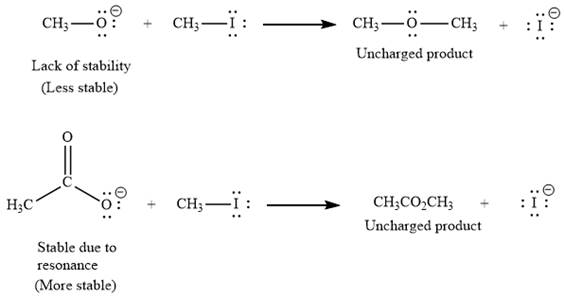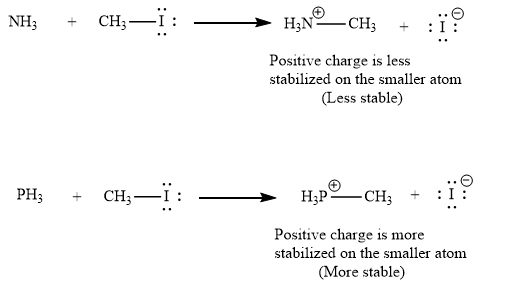
(a)
Interpretation:
It is to be predicted which of the two nucleophiles in the given pair will react faster with
Concept introduction:
The minimum amount of energy required by reacting molecules to reach the transition state is called the activation energy.
For nucleophilic substitution reactions, if the reactant is the same, the activation energy increases with increasing stability of the substitution product.
The reaction is faster when the energy barrier between the reactants and products is small. When energy difference between reactants and the transition state is smaller than the energy difference between products and transition state, the reactants are highly reactive and reaction is faster. Highly reactive reactant molecules serve as strong nucleophiles. The reactants are less reactive and the reaction slower, when the transition state is closer in energy to the products than the reactants.
Answer to Problem 9.4P
(i) Among the two nucleophiles, the nucleophile
(ii) Among the two nucleophiles, the nucleophile
Explanation of Solution
(i) The first given pair of nucleophiles is
The reactions of each of these nucleophiles with

There is a significant difference in charge stability on the reactant side but not on the product side because the negative charge in
(ii) The second given pair of nucleophiles is
The reactions of each of these nucleophiles with

There is a significant difference in charge stability on the product side but not on the reactant side. Because a positive charge is more stable on phosphorous atom than on nitrogen atom, the product of the nucleophilic substitution involving
Therefore, the energy barrier involving
As nucleophilicity of the attacking species increases in
(b)
Interpretation:
It is to be determined which of the given pairs is the stronger nucleophile.
Concept introduction:
The minimum amount of energy required by reacting molecules to reach the transition state is called the activation energy. For nucleophilic substitution reactions, if the reactant is the same, the activation energy increases with increasing stability of the substitution product. When energy difference between reactants and the transition state is smaller than the energy difference between products and transition state, the reactants are highly reactive and reaction is faster. Highly reactive reactant molecules serves as strong nucleophiles.
Answer to Problem 9.4P
(i) Among the pair of nucleophiles,
(ii) Among the two nucleophiles,
Explanation of Solution
(i) The first given pair of nucleophiles is
In part (a), it is determined that the reaction of
(ii) The first given pair of nucleophiles is
In part (a), it is determined that the reaction of
Among the two given nucleophiles, the stronger nucleophile is the one that exhibits a faster reaction.
Want to see more full solutions like this?
Chapter 9 Solutions
Organic Chemistry: Principles and Mechanisms (Second Edition)
- Write the systematic name of each organic molecule: structure i HO OH Explanation Check name ☐ ☐arrow_forwardX 5 Check the box under each molecule that has a total of five ẞ hydrogens. If none of the molecules fit this description, check the box underneath the table. CI Br Br Br 0 None of these molecules have a total of five ẞ hydrogens. Explanation Check esc F1 F2 tab caps lock fn Q @2 A W # 3 OH O OH HO © 2025 McGraw Hill LLC. All Rights Reserved. Terms of Use | Privacy Center | Accessibility IK F7 F7 F8 TA F9 F10 & 6 28 * ( > 7 8 9 0 80 F3 O F4 KKO F5 F6 S 64 $ D % 25 R T Y U பட F G H O J K L Z X C V B N M H control option command P H F11 F12 + || { [ command optionarrow_forwardAn open vessel containing water stands in a laboratory measuring 5.0 m x 5.0 m x 3.0 m at 25 °C ; the vapor pressure (vp) of water at this temperature is 3.2 kPa. When the system has come to equilibrium, what mass of water will be found in the air if there is no ventilation? Repeat the calculation for open vessels containing benzene (vp = 13.1 kPa) and mercury (vp = 0.23 Pa)arrow_forward
- Every chemist knows to ‘add acid to water with constant stirring’ when diluting a concentrated acid in order to keep the solution from spewing boiling acid all over the place. Explain how this one fact is enough to prove that strong acids and water do not form ideal solutions.arrow_forwardThe predominant components of our atmosphere are N₂, O₂, and Ar in the following mole fractions: χN2 = 0.780, χO2 = 0.21, χAr = 0.01. Assuming that these molecules act as ideal gases, calculate ΔGmix, ΔSmix, and ΔHmix when the total pressure is 1 bar and the temperature is 300 K.arrow_forwarddG = Vdp - SdT + μA dnA + μB dnB + ... so that under constant pressure and temperature conditions, the chemical potential of a component is the rate of change of the Gibbs energy of the system with respect to changing composition, μJ = (∂G / ∂nJ)p,T,n' Using first principles prove that under conditions of constant volume and temperature, the chemical potential is a measure of the partial molar Helmholtz energy (μJ = (∂A / ∂nJ)V,T,n')arrow_forward
- The vapor pressure of dichloromethane at 20.0 °C is 58.0 kPa and its enthalpy of vaporization is 32.7 kJ/mol. Estimate the temperature at which its vapor pressure is 66.0 kPa.arrow_forwardDraw the structure of A, the minor E1 product of the reaction. Cl Skip Part Check F1 esc CH_CH OH, D 3 2 Click and drag to start drawing a structure. 80 R3 F4 F2 F3 @ 2 # $ 4 3 Q W 95 % KO 5 F6 A F7 × G ☐ Save For Later Sub 2025 McGraw Hill LLC. All Rights Reserved. Terms of Use | Privacy C ►II A A F8 F9 F10 FL 6 7 88 & * 8 9 LLI E R T Y U A S D lock LL F G H 0 P J K L Z X C V B N M 9 Harrow_forwardFrom the choices given, which two substances have the same crystal structure? (Select both) Group of answer choices ZnS (zincblende) Diamond TiO2 (rutile) ZnS (wurtzite)arrow_forward
- Potassium (K) blends with germanium (Ge) to form a Zintl phase with a chemical formula of K4Ge4. Which of the following elements would you expect potassium to blend with to form an alloy? Electronegativities: As (2.0), Cl (3.0), Ge (1.8), K (0.8), S (2.5), Ti (1.5) Group of answer choices Arsenic (As) Sulfur (S) Chlorine (Cl) Titanium (Ti)arrow_forwardConsider two elements, X and Z. Both have cubic-based unit cells with the same edge lengths. X has a bcc unit cell while Z has a fcc unit cell. Which of the following statements is TRUE? Group of answer choices Z has a larger density than X X has more particles in its unit cell than Z does X has a larger density than Z Z has a larger unit cell volume than Xarrow_forwardHow many particles does a face-centered cubic (fcc) unit cell contain? Group of answer choices 2 14 8 4arrow_forward
 Organic Chemistry: A Guided InquiryChemistryISBN:9780618974122Author:Andrei StraumanisPublisher:Cengage Learning
Organic Chemistry: A Guided InquiryChemistryISBN:9780618974122Author:Andrei StraumanisPublisher:Cengage Learning
